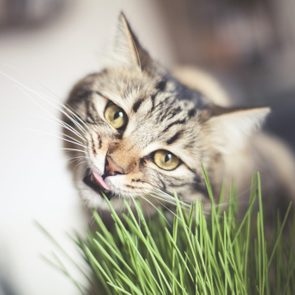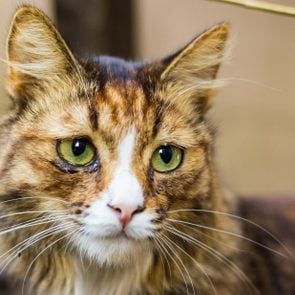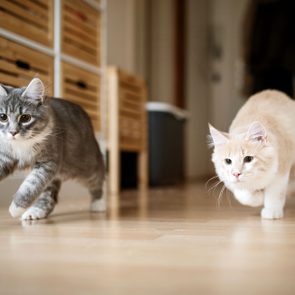How to Keep Cats Away from the Christmas Tree
Updated: Jun. 26, 2024

These expert tips will help cat-proof your Christmas tree
The holidays are the most wonderful time of the year—until your sweet kitty decides that your meticulously decorated tree is a toy. So what’s the secret to how to keep cats away from the Christmas tree? And does the tree itself pose any danger to your mischievous feline friend?
We asked cat experts to share what they know about this common cat behavior and offer their best advice on cats and their rambunctious Christmas tree ideas. Keep scrolling for solutions.
Get Reader’s Digest’s Read Up newsletter for more holidays, humor, cleaning, travel and fun facts all week long.
What attracts cats to Christmas trees?
What is it about cats and Christmas trees? Well, for starters, sparkly lights, bouncing decorations, the scent of evergreen—it makes perfect sense that kitties are drawn to them.
“A Christmas tree is like a giant holiday cat tree filled with dangling ornament prey,” says Kira Ramdas, DVM, president of the American Association of Feline Practitioners. “They can climb it to perch in good vertical space—a requirement for a healthy, cat-friendly environment—hide under or within its branches, sniff outside smells from living trees and bat little objects off into space, which can then be chased and batted underneath the stove, never to be seen again.” (FYI, here’s why cats knock things over with an impressive lack of care for your belongings.)
She adds that cats are also both a prey and predator species. That means hiding within those tall branches is on-brand for them. Throw in some dazzling, eye-catching Christmas decorations and flickering lights, and your cat might just feel like they’ve arrived in Vegas.
Are Christmas trees toxic to cats?
They can be. Don LeHoullier, DVM, owner of Countryside Veterinary Clinic, notes that some fresh Christmas trees are toxic to cats, and the tree itself poses a number of hazards.
“Fir trees are mildly toxic, and the oils they produce can be irritating to the cat’s mouth and digestive tract, though it is unlikely they would ingest enough of the oils to cause a major issue,” he notes. “Ingesting the bark or needles of a Christmas tree can also lead to digestive upset, vomiting, diarrhea and in some cases intestinal obstruction or perforation.”
Dr. LeHoullier adds that drinking water from the tree base is also unsafe, since it may be contaminated with bacteria, fertilizer or other chemicals. This can lead to digestion issues, including vomiting or diarrhea. If your cat eats the needles or drinks the water and shows any of the above signs, call your veterinarian. It’s always better to be proactive. And in situations where cats are very interested in chewing the leaves or drinking the water, you may find more peace of mind by simply getting an artificial Christmas tree.
As for the Christmas tree decorations, broken glass ornaments can lead to injury, electrical cords for string lights are a hazard and ingesting small baubles can cause problems too. And finally, Christmas trees aren’t 100% sturdy, so in addition to learning how to keep cats away from a Christmas tree, Dr. Ramdas strongly recommends anchoring the tree for you and your cat’s safety.
How to keep cats away from the Christmas tree
Taking time to cat-proof Christmas trees means you’ll be able to celebrate the holidays with your pet without losing your sanity—or worrying about your cat’s safety. Though you may deal with some trial and error in the beginning, following these steps for how to keep cats out of Christmas-tree trouble will help keep you both happier and safer.
Wait to decorate for a few days
Set up and anchor the tree for a few days before adding any decorations. “This gives kitty the chance to investigate, sniff and climb, leaving you free to add your family heirlooms when the novelty has worn off for most cats,” Dr. Ramdas says. Consider using eye hooks and fishing line to secure the tree to the wall and ceiling, making sure not to leave any excess accessible to your cat for them to toy with either.
Don’t place the tree near launch zones
Put your Christmas tree in an area free of launch zones, which are spots like a cat tower where cats can readily jump to higher places. Dr. Ramdas says that nearby furniture makes an excellent runway for kitty takeoff, which presents a great opportunity to launch themselves right into the middle of that fragrant greenery. And it never hurts to pay attention to cat body language to determine if they may be in the mood to play and pounce.
Create a barrier between the tree and your cat
A physical barrier, such as a pet fence or play pen, can help keep your cat from being able to explore the tree from the ground. “Make sure the bars of the barrier are vertical because horizontal or grid patterns are easy to climb,” says Dr. LeHoullier.
Use a safe cat-deterrent spray
For a safe and natural way to keep cats away from Christmas trees, consider spritzing a feline-approved deterrent spray on the bottom half of the tree. Make sure the product is pet-safe—NaturVet Bitter Yuck! No Chew Spray is a veterinary favorite. Do not use essential oils, cayenne pepper or cinnamon to keep cats from Christmas trees, since these substances aren’t cat-safe. They can cause irritation and gastric upset if ingested. Cat-safe deterrent sprays can also keep a cat from scratching furniture.
Try aluminum foil
Wrapping the trunk base and floor with aluminum foil is another natural way to cat-proof a Christmas tree. Cats dislike the feeling of foil, and this helps them become disinterested in the tree altogether. Once they’ve found new exciting things to explore, you can nix the unsightly foil.
Provide an alternative play area
Cat parents should also giveth when they taketh away. “Having perches or a multilevel play structure [away from the tree but in the same room] complete with toys, scratching posts and even a cat-safe plant, like catnip, can provide an alternative to the Christmas tree,” Dr. LeHoullier explains. “This can help satisfy a cat’s desire to climb, scratch and chew the tree.”
Put the tree in an off-limits area
If you’re still struggling to keep your cat away from the Christmas tree in the living room, you may want to locate it elsewhere. Dr. Ramdas says, “Set up the tree in a room off-limits to the kitties, or if you have an open-plan [home] and no common areas to close off, try a table-top tree that can be moved to a bedroom when [the cat is] not being supervised.”
About the experts
- Kira Ramdas, DVM, is the president of the American Association of Feline Practitioners.
- Don LeHoullier, DVM, is the owner of Countryside Veterinary Clinic in Jefferson, Oregon, and an ambassador for Care Credit.





















